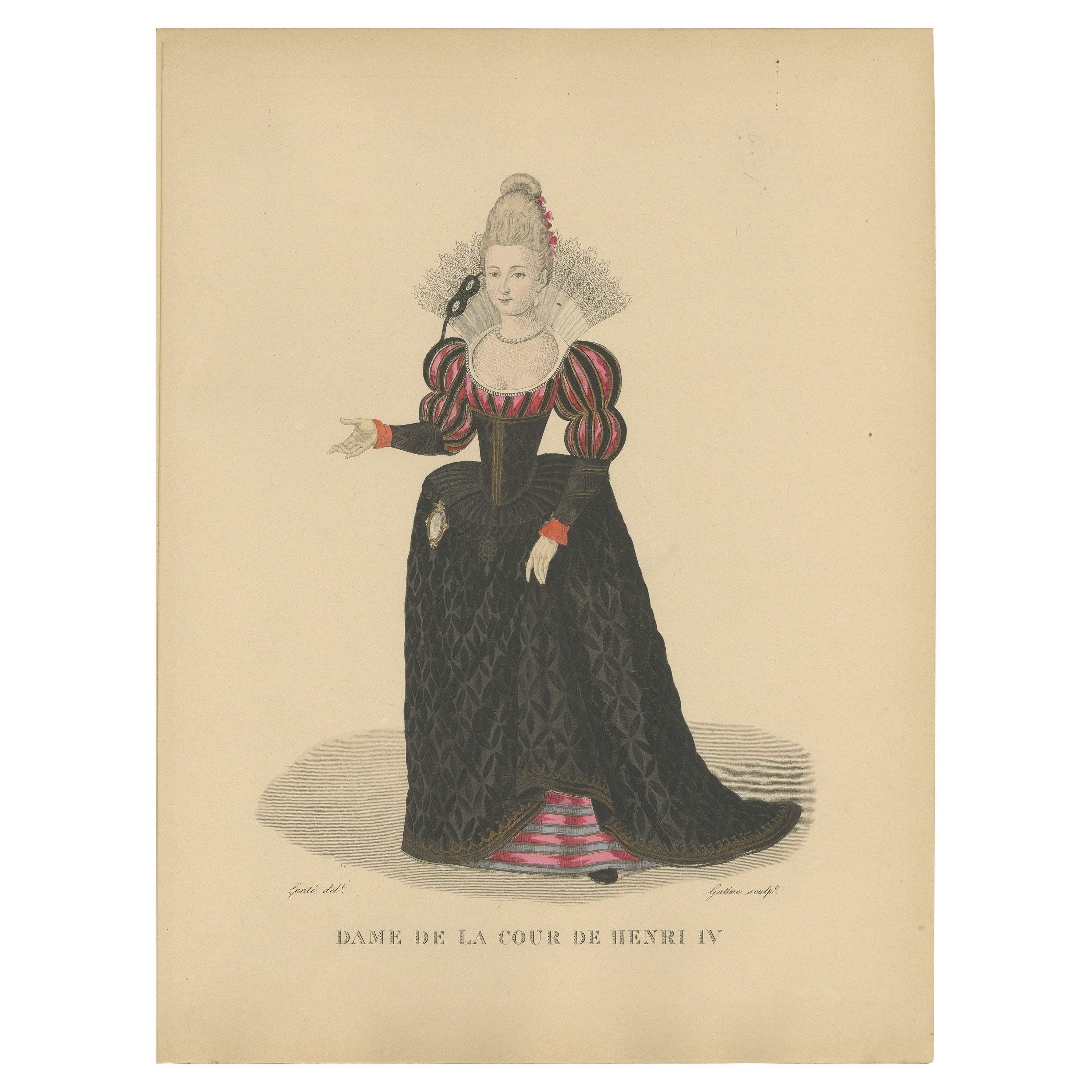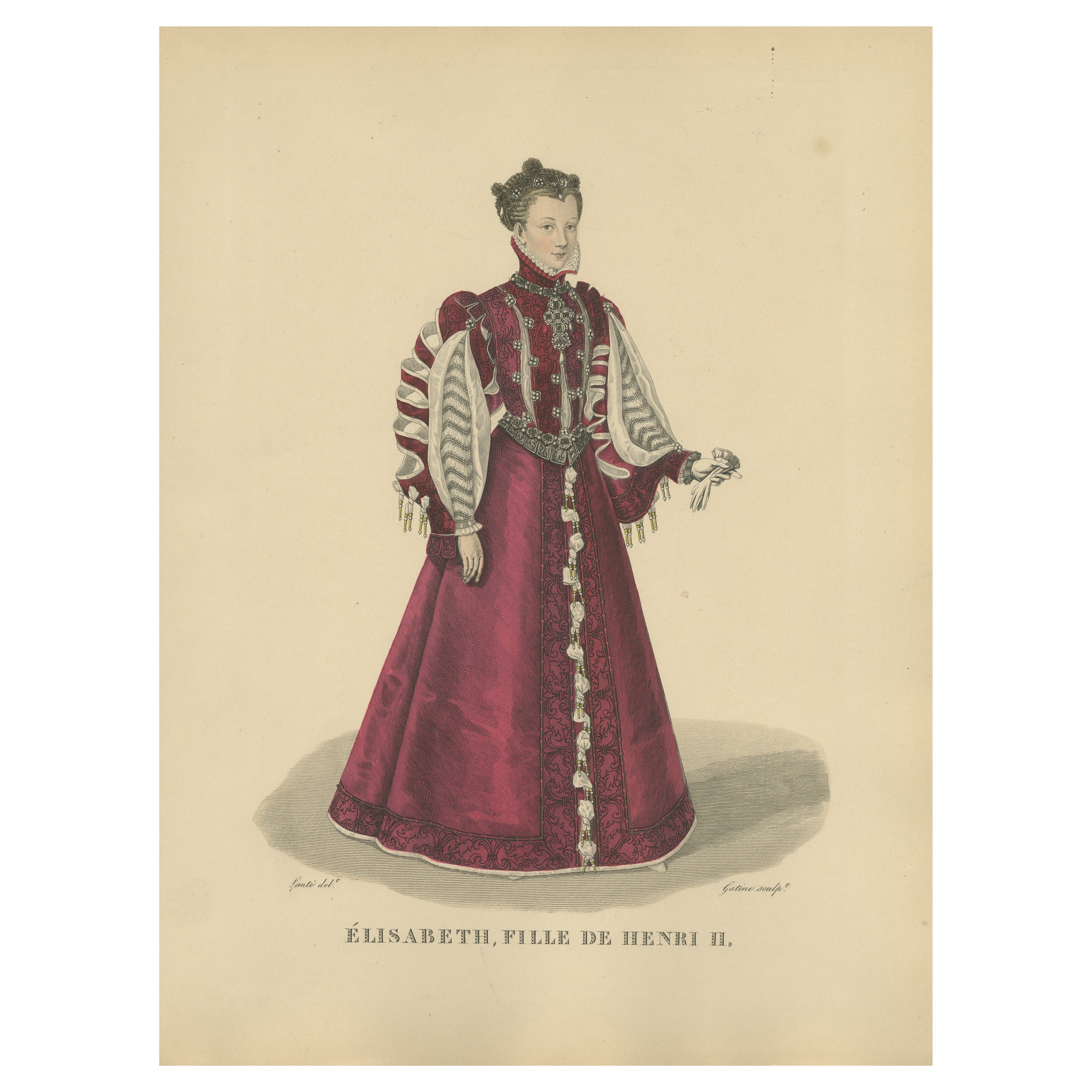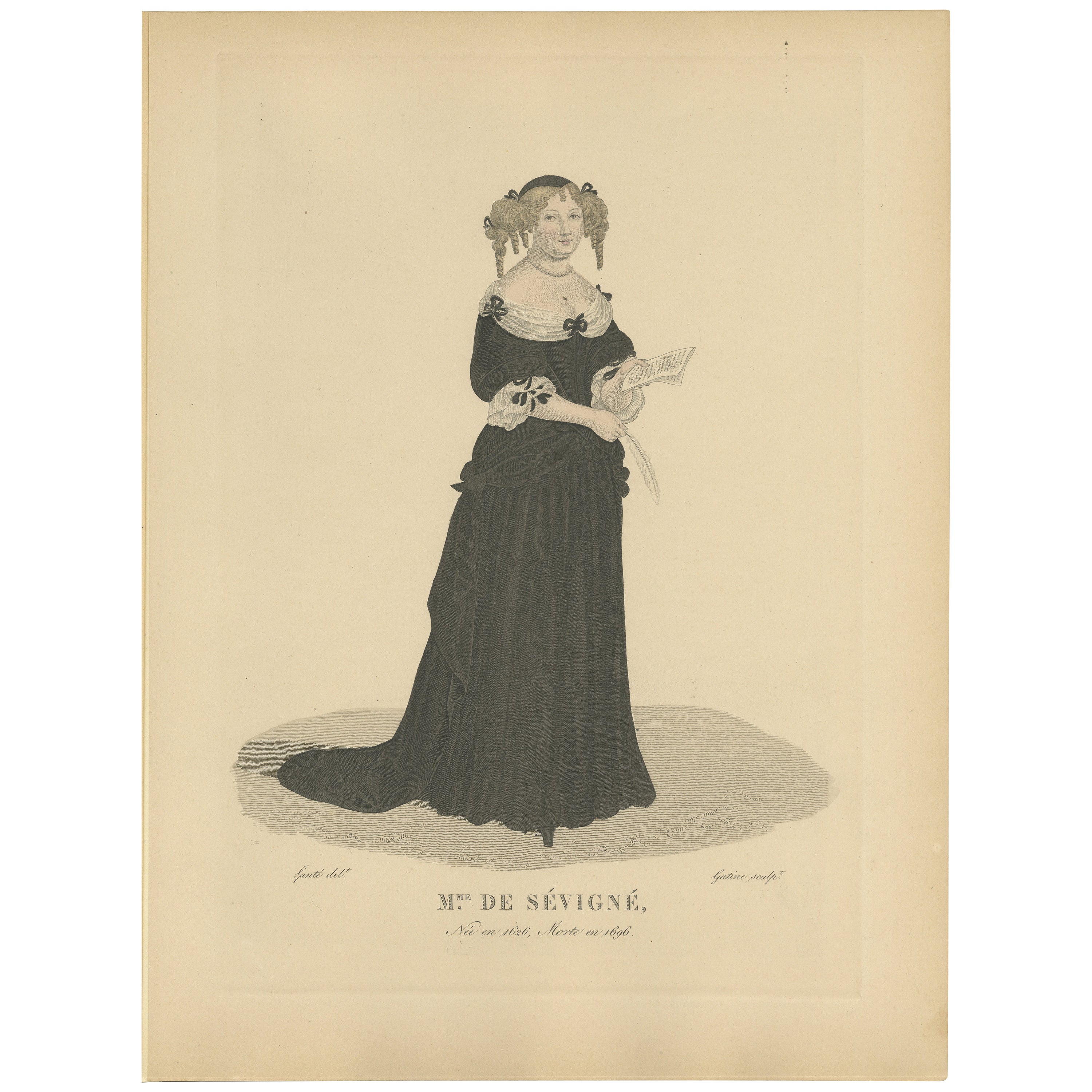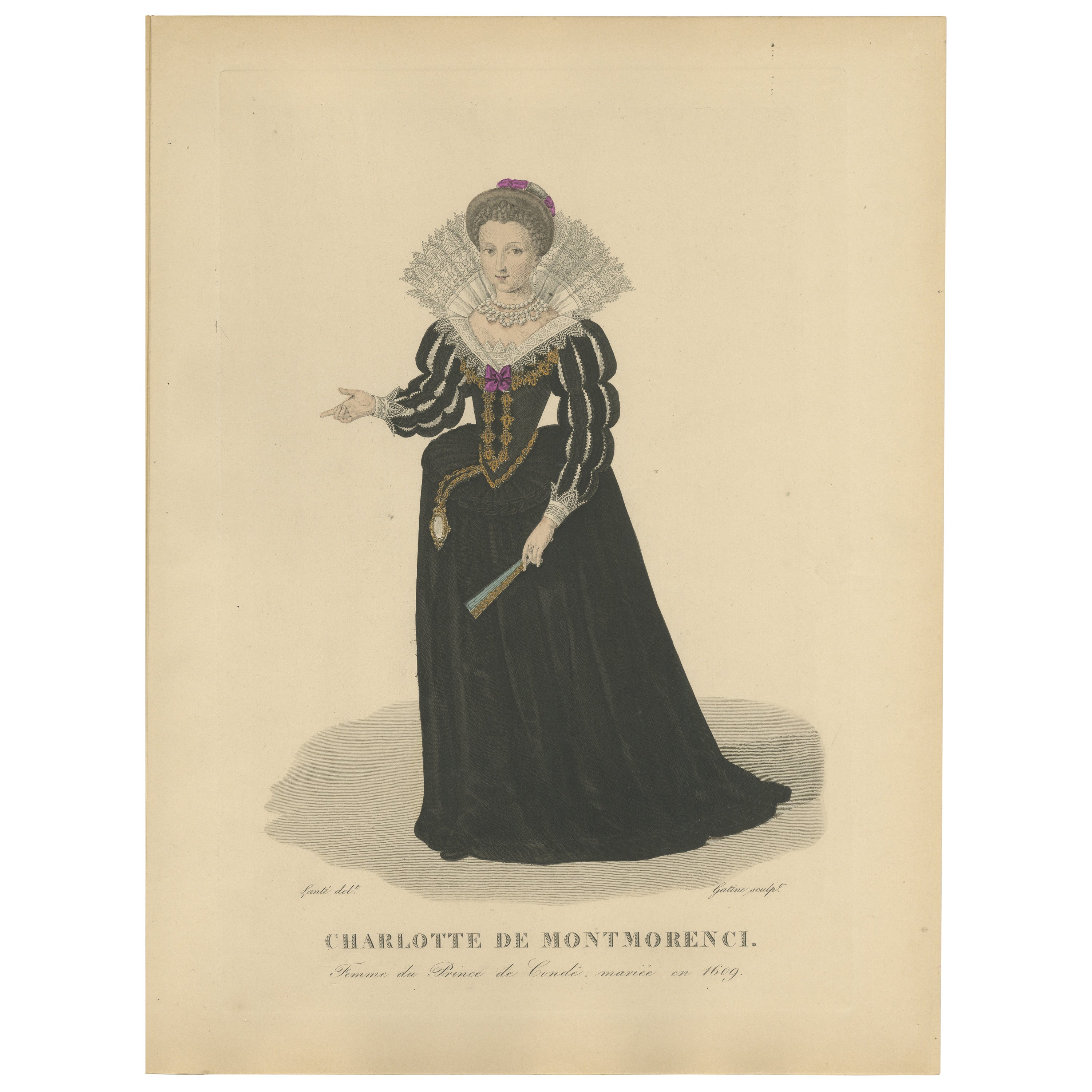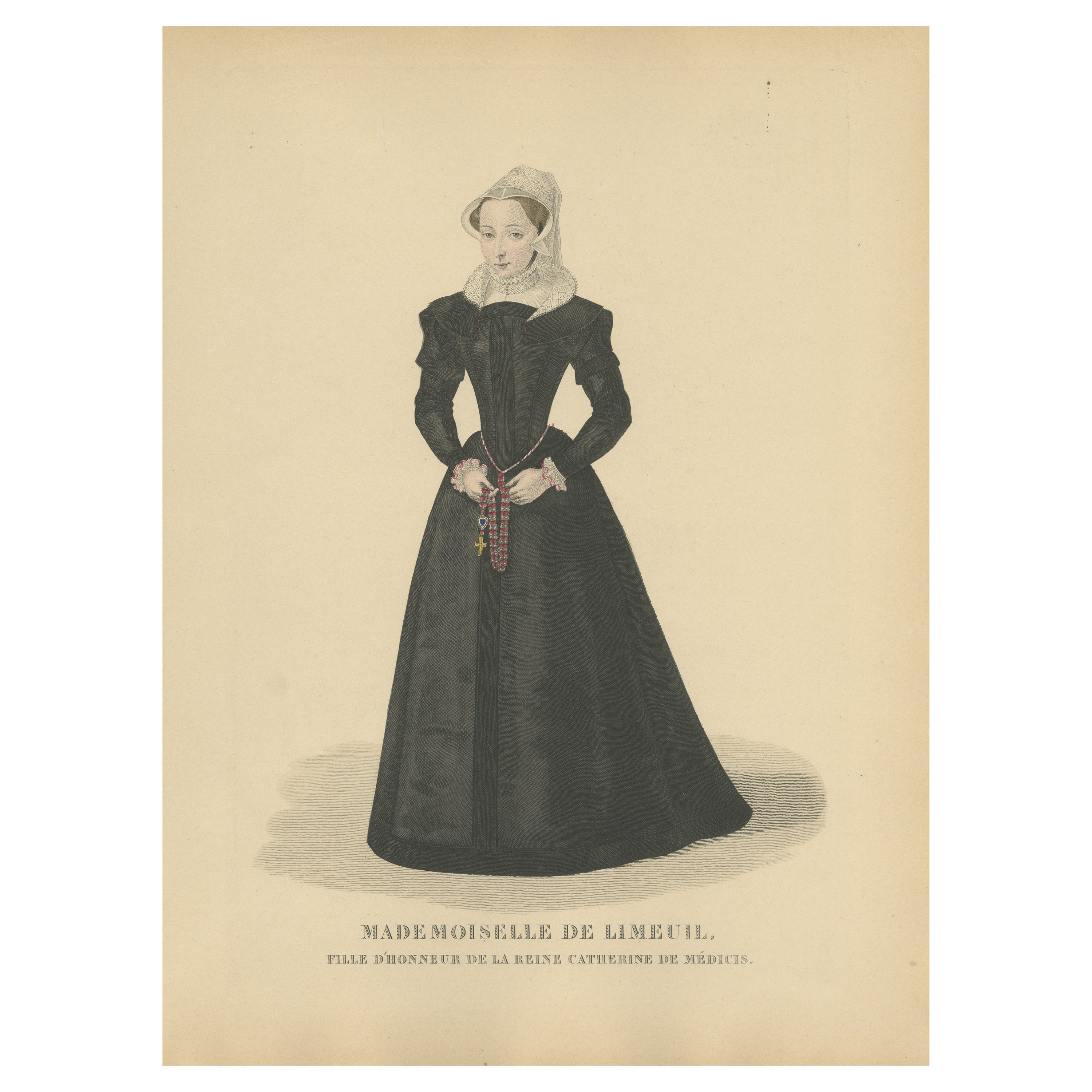Items Similar to C. 1625 After Antoine de Pluvinel, "Henry IV, Mounted", Hand Colored Engraving
Want more images or videos?
Request additional images or videos from the seller
1 of 16
C. 1625 After Antoine de Pluvinel, "Henry IV, Mounted", Hand Colored Engraving
About the Item
Early 17th century, French hand colored equestrian engraving. After Antoine de Pluvinel (French, 1552-1620), "Henry IV, Mounted", figure 42 from "L'Instruction du Roy en l'Exercice de Monter a Cheval", c. 1625, matted and framed under UF-3 plexiglass (blocks approx. 97% of UV) , gallery label verso. Figures from this publication have sold at Christie's. Those were not hand colored.
A highly detailed engraving with the French King Henry 1V the central figure. Mounted on horseback, Le Roy (the King) is watched by no less than 10 courtiers some of whom are mounted on horseback, all of which are named in the engraving.
Antoine de Pluvinel (1552, Crest, Dauphine - 24 August 1620) was the first of the French riding masters, and has had great influence on modern dressage. He wrote L’Instruction du Roy en L'exercice de Monter à Cheval ("instruction of the King in the art of riding"), was tutor to King Louis XIII, and is credited with the invention of using two pillars, as well as using shoulder-in to increase suppleness.
In 1594, Pluvinel founded the "Academie d'Equitation" near what is now Place des Pyramides. There, the French nobility was trained not only in horsemanship, but also in all the accomplishments (dancing, fashionable dressing, etc.) It can be said that Pluvinel's influence on the aristocracy lasted from the late 16th century to the 17th century. Richelieu, the future Prime Minister of King Louis XIII attended the Academie; so did William, Duke of Cavendish.
Pluvinel's book was published posthumously by the Flemish engraver Crispijn van de Passe II and the royal valet de chambre J.D. Peyrol, first in 1623 under the name "Le Maneige Royal", with magnificent engravings, but having never been edited. In 1625 the book was published in its complete form, having been edited by Pluvinel's friend Menou de Charnizay, under its definitive name "L'Instruction du Roy en L'exercice de Monter à Cheval".
Dimensions:
13.25" H x 16.5" W (sight), 22.5" H x 25.5" W (frame)
Condition:
Good. Not examined out of frame.
Provenance:
Lombard Antiquarian Maps & Prints, Cape Elizabeth, Maine.
- Dimensions:Height: 22.5 in (57.15 cm)Width: 25.5 in (64.77 cm)Depth: 0.5 in (1.27 cm)
- Style:Baroque (Of the Period)
- Materials and Techniques:
- Place of Origin:
- Period:Early 17th Century
- Date of Manufacture:1625
- Condition:Wear consistent with age and use.
- Seller Location:Morristown, NJ
- Reference Number:1stDibs: LU5990231313872
About the Seller
4.9
Platinum Seller
These expertly vetted sellers are 1stDibs' most experienced sellers and are rated highest by our customers.
Established in 2020
1stDibs seller since 2021
122 sales on 1stDibs
Typical response time: <1 hour
- ShippingRetrieving quote...Ships From: Morristown, NJ
- Return PolicyA return for this item may be initiated within 14 days of delivery.
More From This SellerView All
- 1825 Hand-Colored Aquatint Engraving by T. Sutherland "South Sea Whale Fishery"By William John HugginsLocated in Morristown, NJA hand-colored aquatint engraving dated January 1, 1825 and engraved by T. Sutherland, London. Titled "South Sea Whale Fishery", after a painting by Will...Category
Antique 1820s English George IV Prints
MaterialsGlass, Wood, Giltwood, Paper
- "in Full Cry" English Equestrian Hunt Scene by Henry Alken Framed under GlassBy Henry AlkenLocated in Morristown, NJHenry Thomas Alken (1785-1854) artist, a fox hunting lithograph: "In Full Cry Yoi Forward". Engraved by F. C. Lewis. Published by Tregear & Co. 90 C...Category
Antique 19th Century English Georgian Prints
MaterialsGlass, Wood, Paper
- Baron Rais d'Eisenberg, Hand-Colored Equestrian Engraving c. 1747, "Le Brillant"By EisenbergLocated in Morristown, NJ18th century German, a hand-colored engraving of a dressage horse and rider from Description du Manège Moderne by Friedrich Wilhelm, Baron Rais d' Eisenberg (German, ca. 1700-ca. 1770). Engraved by Bernard Picart (French, 1673-1733). Titled "Le Brillant", this dressage engraving is plate XXXIII. There is a gallery label verso. The print is matted and framed under UF-3 plexiglass, which offers the maximum amount of UV protection (approx. 97%). This print was originally part of an illustrated book Baron d'Eisenberg made describing the art of the cavaliers and depicting the different breeds of horses- The full title of the book is L'Art de Monter a Cheval: ou Description du Manége Moderne, Dans sa Perfection, published in Leipzig: Arkstée et Merkus, 1747). A set of 7 framed engravings from the same book sold at Sotheby's for $9,500 (plus tax and buyers premium). Reference: The author, a German horseman and artist, spent some of his youth at the manège of Saxe-Weimar before entering into the service of the Emperor. He then spent six years in Naples as the Master of Horse of the Viceroy before returning to Vienna where he studied under M. de Regenthal, the imperial Master of Horse. He participated in the coronation of the Emperor Charles V at Frankfurt in 1711, then spent some time in England, but was back in Germany before 1753. He probably died in Tuscany where he was Director and Master of the Horse at the Academy in Pisa. Brunet II, 957; Mennessier de la Lance I, p. 438. The Baron wrote several important and lavishly illustrated books on horses: his Description du manège moderne dans sa perfection, London 1727, and Dictionnaire des termes du manège moderne, 1747, being the best well-known. He dedicated Description du Manège Moderne to King George II and to his son, His Royal Highness the Prince of Wales. Subscribers to the book included royalty and nobility from all over Europe. The engraver was Bernard Picart, born in Paris in 1673. He gained honors at the Academy of Paris at the age of sixteen. He was a master designer and engraver and worked in Paris and Amsterdam until his death in 1733. Dimensions: 9"h x 12"w (sight), 16.5"h x 19.25"w (frame) Condition: Good, some rippling to sheet, not examined out of frame. Provenance: Lombard Antiquarian Maps & Prints, Cape Elizabeth...Category
Antique 1740s German Rococo Drawings
MaterialsPlexiglass, Wood, Paint, Paper
- Framed Antique Chromolithograph - Uffizi Gallery Ceiling, Florence, ItalyLocated in Morristown, NJAntique German architecture print on heavy paper showing an illustration of a portion of a ceiling painting in the Uffizi Gallery, Florence, 16th centur...Category
Antique 1890s German Renaissance Prints
MaterialsGlass, Wood, Paper
- Framed Antique Chromolithograph - Uffizi Gallery Ceiling, Florence, ItalyLocated in Morristown, NJAntique German architecture print on heavy paper showing an illustration of a portion of a ceiling painting in the Uffizi Gallery, Florence, 16th centur...Category
Antique 1890s German Renaissance Prints
MaterialsGlass, Wood, Paper
- 19th C., Vanity Fair Framed Chromolithographs of Gentlemen Ex. Christie's, 12By Sir Leslie WardLocated in Morristown, NJ[English Gentlemen], from Vanity Fair twelve chromolithographs, on wove papers. Printed by Vincent Brooks Day & Son., with various dates from 1875 to 1897. Eight are by Spy, two are by Ape, one by "T" and one by Lib. Professionally framed with black and gilt frames and beige silk mats, with margins, apparently in excellent condition, not examined out of the frames. Titles comprise: "Accrington", June 11, 1892, "Newcastle Upon Tyne" July 18, 1893, "A New Peer", October 5, 1878, "South Bucks", June 4, 1896, "South Kensington", September 2, 1897, "Lord Salisbury's Manners", July 13, 1893, "The Blister", August 4, 1888, "A Postmaster General", April 30, 1892, "Sir James Miller", September 6, 1890, "Sol", October 28, 1897, "A Young Man" September 11, 1875, and "A Naturalist", September 9, 1882. Vanity Fair was a weekly magazine published in London, founded & edited by Thomas Gibson Bowles. His aim was to expose to contemporary vanities of Victorian society. From 1868 to 1914, full page colour lithographs appeared in most weekly issues, frequently lampooning or lauding their subjects which included artists, athletes, royalty, politicians, scientists, authors, actors, sportsmen, lawyers, diplomats, soldiers, clergy, scholars and other celebrities of the day - mostly British, but also many other internationally significant personalities. Over 2,300 of these colour cartoons were printed, and they are considered the chief cultural legacy of the magazine, forming a pictorial record of many of the most significant public figures of the period. They are renowned throughout the world and highly collectible and recognisable. Famous artists contributed to Vanity Fair, typically under pen names. The best remembered today is Leslie Ward (1851-1922), who signed his works as "Spy", and whose caricatures account for well over half of those featured in Vanity Fair. So famous have these fabulous prints become, Vanity Fair caricatures today often are referred to simply as "Spy Cartoons...Category
Antique Late 19th Century English Late Victorian Prints
MaterialsGlass, Wood, Paper
You May Also Like
- Hand Colored Engraving of Woman at the Court of King Henry IV of France, 1900Located in Langweer, NLAntique print titled 'DAME DE LA COUR DE HENRI IV' Original antique print of Woman at the court of King Henry IV of France. This print originates from ' LA MÉSANGÈRE, Pierre and LANTÉ, Louis Marie. Costumes des Femmes Françaises du XIIe au XVIIIe siècle. Paris: Librairie Charles Tallandier, 1900. This beautiful work tracing changes in French costume...Category
Early 20th Century Prints
MaterialsPaper
- Hand Colored Engraving of OpossumsLocated in Langweer, NLOriginal antique print of opossums. Originates from Bertuch's 'Bilderbuch für Kinder'. In 1790 Friedrich Justin Bertuch started his biggest book-project ever. Issued in 12 volumes it...Category
Antique Late 18th Century Prints
MaterialsPaper
- Hand Colored Engraving of Elisabeth of Valois, Daughter of Henry II, 1900Located in Langweer, NLAntique print titled 'ELISABETH' Original antique print of Elisabeth, daughter of Henry II of France. Elisabeth of France or Elisabeth of Valois (2 April 1545 – 3 October 1568) was Queen of Spain as the third spouse of Philip II of Spain...Category
Early 20th Century Prints
MaterialsPaper
- Hand Colored Engraving of Marie de Rabutin-Chantal, Madame de Sévigné, 1900Located in Langweer, NLAntique print titled 'MADAME DE SEVIGNE' Original antique print of Marie de Rabutin-Chantal, Madame de Sévigné. Marie de Rabutin-Chantal, marquise de Sévigné (5 February 1626 – 17 April 1696), also widely known as Madame de Sévigné or Mme de Sévigné, was a French aristocrat, remembered for her letter-writing. Most of her letters, celebrated for their wit and vividness, were addressed to her daughter, Françoise-Marguerite de Sévigné. She is revered in France as one of the great icons of French 17th-century literature. Marie de Rabutin-Chantal was born in the fashionable Place des Vosges (then called the Place Royale), Paris, to an old and distinguished family from Burgundy. Her father, Celse Bénigne de Rabutin, baron de Chantal, was the son of Saint Jane Frances de Chantal, a friend and disciple of Saint Francis de Sales...Category
Early 20th Century Prints
MaterialsPaper
- Hand Colored Engraving of Charlotte Marguerite, Princess de Condé, 1900Located in Langweer, NLAntique print titled 'CHARLOTTE- MARGUERITE DE MONTMORENCI' Original antique print of Charlotte Marguerite de Montmorency. Charlotte Marguerite de Montmorency (11 May 1594 – 2 Dec...Category
Early 20th Century Prints
MaterialsPaper
- Hand Colored Engraving of Isabelle de Limeuil, a French Noblewoman, 1900Located in Langweer, NLAntique print titled 'MADEMOISELLE DE LIMEUIL' Original antique print of Isabelle de Limeuil, a French Noblewoman . Isabelle de la Tour, Lady of Limeuil (c. 1535 – 25 March 1609) ...Category
Early 20th Century Prints
MaterialsPaper
Recently Viewed
View AllMore Ways To Browse
Shoulder Mount
Pillar Print
16th C Frame
J And H Used Furniture And Antique
17th Century Early Baroque Painted
French Antiquarians
French Valet
Louis Iv
Watches That Can Be Engraved
16th 17th Century Baroque
August King
King William Iv
Dauphine Furniture
Antique Valet
Valet Antique
16th Century Hand Colored Map
Antoine Henry
J C Roy
